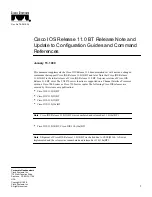
configure esrp election-policy
ExtremeWare XOS 11.5 supports only the Summit X450 family of switches and the BlackDiamond 8800 series switch.
ExtremeWare XOS 11.5 Command Reference Guide
1257
Default
In extended mode, the default election algorithm is
sticky > ports > weight > track > priority
> mac
.
In standard mode, the default election algorithm is
ports > track > priority > mac
.
Usage Guidelines
The election algorithm determines the order of precedence of the election factors used to determine the
ESRP Master. The election factors are:
●
Stickiness (
sticky
): the switch with the higher sticky value has higher priority. When an ESRP
domain claims master, its sticky value is set to 1 (available in extended mode only).
●
Active Ports (
ports
): the number of active ports (the switch with the highest number takes priority)
●
Tracking Information (
track
): whether the switch is using ESRP tracking. A switch using tracking
has priority.
●
ESRP Priority (
priority
): a user-defined priority number between 0 and 254. A higher number has
higher priority. The default priority setting is 0. A priority setting of 255 makes an ESRP switch a
standby switch that remains in slave mode until you change the priority setting. Extreme Networks
recommends this setting for system maintenance. A switch with a priority setting of 255 will never
become the master.
●
MAC address (
mac
): the switch MAC address. A higher-number address has priority.
●
Active port weight (
weight
)—The switch that has the highest port weight takes precedence. The
bandwidth of the port automatically determines the port weight (available only in extended mode).
ESRP does not count ports with a weight of 0 (known as don’t count ports) regardless of ESRP
running in extended or standard mode.
The election algorithm must be the same on all switches for a particular ESRP domain. The election
algorithms that use sticky are and weight are available in extended mode only.
In ExtremeWare XOS 11.0, the extended mode default election algorithm is:
sticky > ports > track
> priority > mac > weight.
This election algorithm is not supported in ExtremeWare XOS 11.1.
Factors to Consider.
The
ports-track-priority
or
track-ports-priority
options can be used to
ensure that there is no failback if the original Master recovers (the Master will have the same ports,
tracks and priority, but a higher MAC).
Any of the options with sticky can also be used to ensure that there is no failback if the original master
recovers. With sticky, if an event causes the ESRP master to failover, ESRP assigns the new master with
the sticky count of 1. After sticky is set on the master, regardless of changes to its neighbor’s election
algorithm, the new master retains its position. For example, adding active ports to the slave does not
cause the new master to failback to the original master, even if the slave has more active ports than the
master. Sticky algorithms provide for fewer network interruptions than non-sticky algorithms. Sticky is
set on the master switch only.
sticky > track > ports > priority
Specifies that this ESRP domain should consider election factors in the
following order: Stickiness, tracking information, active ports, ESRP priority.
track > ports > priority
Specifies that this ESRP domain should consider election factors in the
following order: Tracking information, active ports, ESRP priority.
track > ports > priority > mac
Specifies that this ESRP domain should consider election factors in the
following order: Tracking information, active ports, ESRP priority, MAC address.
















































